Germany Bundesliga
Niclas Füllkrug: Germany’s New ‘Old’ Striker Continues His Ascent

[ad_1]
theanalyst.com
Niclas Füllkrug isn’t your archetypal modern German striker. When the Germans warmed up for their 2022 World Cup campaign with a friendly against Oman in mid-November, Füllkrug came off the bench at half-time. In doing so, he became the oldest outfielder to make his debut for Germany in 20 years (29 years, 280 days).
Did he make an impact? You could say that. He scored the only goal of the game within 35 minutes of his international introduction with what was only his second shot for the national team.
For a while now, German football hasn’t focussed on producing strikers of his ilk. The last time a ‘true nine’ played for Germany was Miroslav Klose, who retired after achieving World Cup glory in 2014 in Brazil. Since then, Timo Werner has been tried and tested in the role but hasn’t worked out as hoped. Mario Gomez was past his best during this period. Kai Havertz may be current manager Hansi Flick’s favourite in the role, but Füllkrug impressed in his cameo appearances at the World Cup in Qatar.
“’Fülle’ can be important for the national team, just like he is for us. There are outstanding technical players [ahead of him], but if you want to play with a classic nine, I don’t think there’s anyone better.”
Werder Bremen’s Niklas Stark on Füllkrug
On paper, the World Cup game between Spain and Germany was the highest standard of the group matches at the tournament. The game was a flurry of fast-paced action and technical quality, with top class players on display across the pitch. But it took a rugged, 6-foot-2 Hanover native to bring Germany back to life.
Again, it was as an impact substitute. Just 13 minutes and 10 seconds after coming off the bench, Füllkrug blasted home the equaliser with what was already his third attempt in the game. The burly striker was kryptonite to the Spanish, with his style of play unlike that of any of the other 28 outfield players to play a part in the match. An antithesis to the Spanish craft.
Füllkrug’s career has been more unconventional than your average international striker, with him only making his 100th top-flight appearance in the same season that he turns 30 years old. How has he emerged as a credible attacker at international level so (relatively) late into his career?
Füllkrug’s Background
This is far from Füllkrug’s breakout season in the Bundesliga. Back in 2017-18 while at Hannover 96, the striker finished joint-third in the German top-flight scoring charts with 14 goals, behind only Robert Lewandowski (29) and Nils Petersen (15).
That season was his first back in the Bundesliga following four successive campaigns in the second tier of German football, where he had an ordinary goalscoring record of 22 goals in 81 games – none of those seasons saw him beat his 2017-18 Bundesliga goal tally, either.
After joining Hannover 96 in 2016-17, he helped his new side achieve promotion back to the Bundesliga after a single season in the second tier. He was their biggest financial outlay in the summer of 2016, with his €2.2m fee from Nürnberg the price after scoring 14 times in 2015-16.
He was to only score five times in 28 league appearances in his first season at the club, as he was overshadowed by team-mate Martin Harnik’s 21 goals on the way to a second-place finish and promotion.
It was a different story in the Bundesliga the following season. Alongside Harnik’s nine goals, Füllkrug’s 14 strikes were crucial to keeping Hannover in the top-flight with a 13th-place finish, six points above the relegation play-off spot.
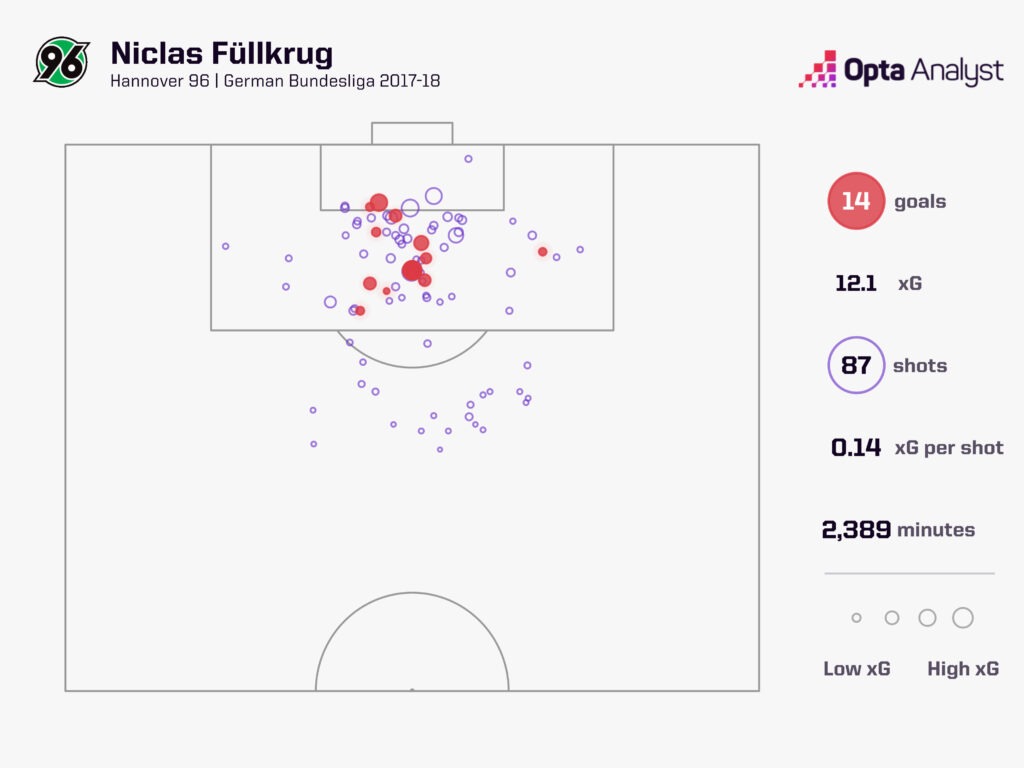
In that season, 75% of his shots came from inside the box, while over a quarter (26.4%) came from headers – only Lewandowski (26) attempted more headed shots than he did of the 16 players to score at least 10 Bundesliga goals that season.
Unfortunately for Füllkrug – and Hannover, who were relegated in the next season – injuries restricted his playing time in 2018-19 and he was to play just 1,112 minutes and score just twice. In fact, including his first two seasons at Werder Bremen in 2019-20 and 2020-21, Füllkrug was to play just 2,392 minutes of top-flight football across three seasons, which was just three minutes more than in his successful 2017-18 campaign with Hannover.
Last season was his comeback season. Whilst relegation to the 2. Bundesliga was a disaster for a Werder Bremen side that had spent 40 consecutive seasons in the top-flight, it turned out to be the reset button that Füllkrug needed. With 19 goals in 33 league appearances, he had his best-ever season in front of goal and fired Werder back to the Bundesliga at the first attempt with a second-place finish.
Fast forward to today, Füllkrug has 10 Bundesliga goals to his name, second only to Christopher Nkunku, and has scored in over half (eight) of his 14 league appearances so far in 2022-23 to help Werder reach ninth position before the World Cup break. Five of those goals have been the opening goal of the game, which is a league-high this season.
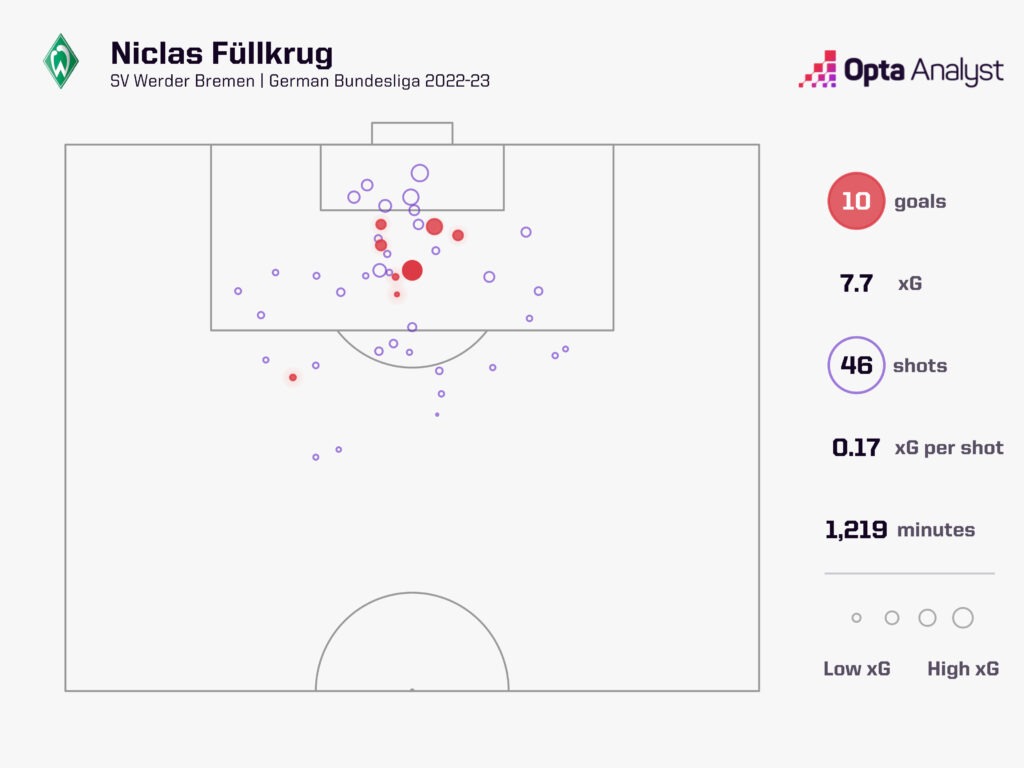
A quick look at his shot map this season shows there is still a healthy concentration of shots in central areas, and in fact, he has been able to get in positions closer to goal now, as evidenced by his shots from within the six-yard area. This is naturally a result of the increased experience under his belt, but also being surrounded by a higher quality of players.
So far this season, he has averaged 0.40 expected goals per 90 from non-penalty shots whilst averaging a very healthy shot volume of 3.2 non-penalty shots per 90 as well. Of players to have played at least 800 minutes of Bundesliga football this season, only five players have a higher non-penalty shot per 90 average than he does; and four of those play for Bayern Munich.
His 0.40 npxG per 90 may be lower than nine others to have played 800 minutes of more in the Bundesliga this season, but when considering his Werder side average just 1.08 per game, Füllkrug’s importance is highlighted.
14 of his shots have come from outside the box in open play, which is only second to Leroy Sané’s 15 in the competition this season. The low-quality pot shots from distance are a result of his tendencies which are important to explore.
More Than Just a Number Nine
In addition to his qualities as a traditional number nine, Füllkrug has a few tendencies and tools in his skillset that make him more than just a simple target man.
In Bremen’s system under Ole Werner, he plays in a front two alongside another tall forward in Marvin Ducksch. Werner’s side are quite unique in this aspect of having two very similar forwards but who each perform various roles in and out of possession.
Looking at Füllkrug’s role in possession for Werder, he will often drop deeper, closer to the halfway line to receive and release passes into space for runners beyond him.
One such example is this pass he plays perfectly into the space that Romano Schmid is running into off the ball. For someone of his size, Füllkrug can be surprisingly good with the weight of his touches and release of passes. Here that pass to Schmid contributes to a sequence that ends in a shot from Lee Buchanan.
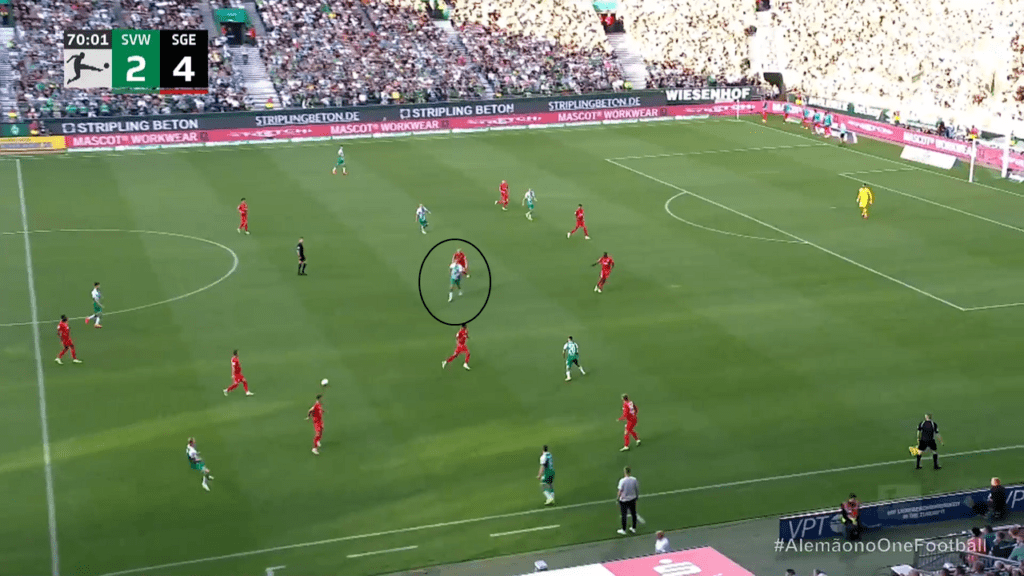
Another instance of his ability to receive to feet and release immediately is evident here against Bochum where he demands the ball to feet and lofts it into space for Schmid to attack the byline and eventually attempt to cross to him to complete the sequence.
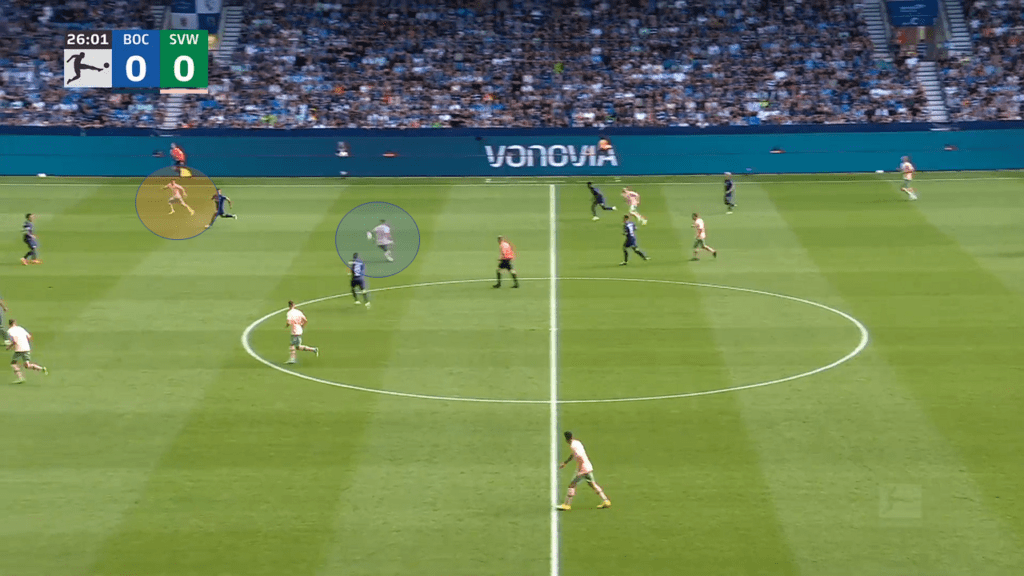
Füllkrug can often just look like a midfielder on the pitch and receives passes in areas where you would normally see a creative number 10 collect the ball.
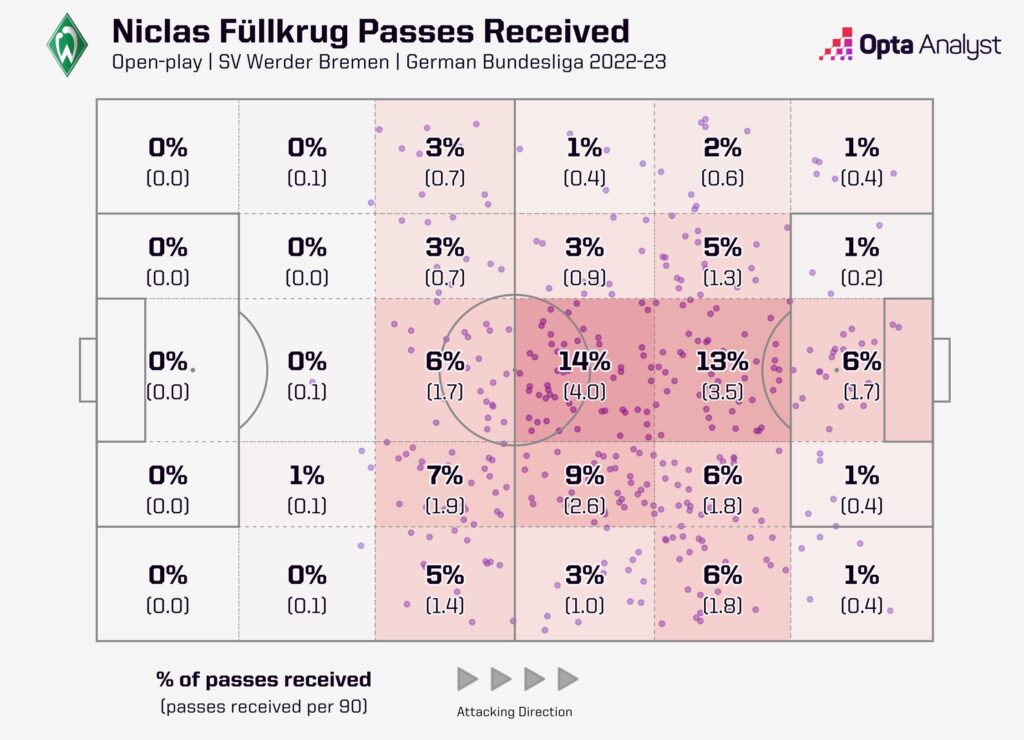
14% of his open play passes received so far this season have been in the central area close to the halfway line, with another 13% coming in zone 14 of the pitch, which once again highlights his willingness to roam and desire to see a lot of the ball.
Interestingly, including all touches and not just open play, 10% of his touches have come inside the opposition box. This is less than half the proportion by another 10-goal Bundesliga striker in 2022-23, Marcus Thuram (20.2%) and fewer than top scorer Nkunku (13.1%).
Zooming out even further and just looking at his open-play touches for Bremen once again paints a clearer picture of a player who is clearly able to do more than just the things you normally expect from a number nine.
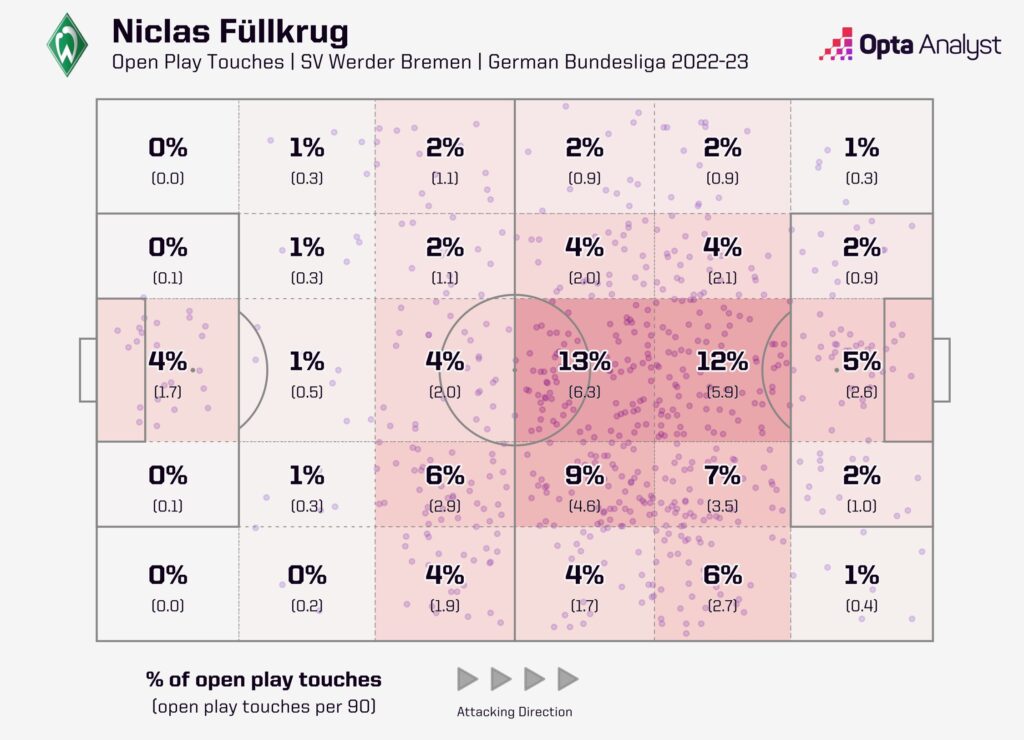
With Füllkrug spending a lot of time on the pitch outside of the penalty area, he becomes a key cog of Bremen’s attacking activity and almost everything goes through him.
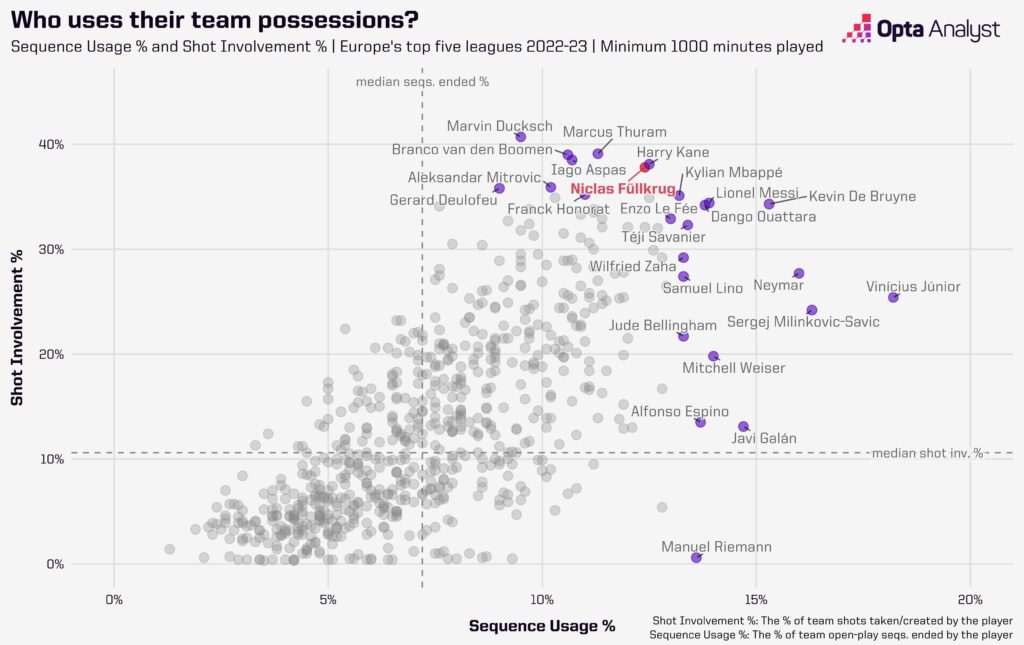
Both him and Ducksch have a high proportion of shot involvement for Bremen, but Füllkrug’s tendencies to drop deep mean that he naturally becomes a part of a greater number of sequences than his partner in crime Ducksch. In the viz above, you’ll see that his data is almost identical to Tottenham’s Harry Kane for shot involvement and sequence usage proportion.
For a team that has only returned to the Bundesliga this season from the 2. Bundesliga, Bremen have been able to perform better in possession than most teams and so far have averaged 50.3% possession, more than nine other sides in the league, including two teams higher than them in the league table; Freiburg and Union Berlin.
A big part of that ability to retain the ball is Füllkrug’s skill to retain possession by collecting deep and being able to hold up the ball whilst Bremen’s offensive eights dart into space along with right-side wing-back Mitchell Weiser, who has a great deal of freedom in Werner’s 3-1-4-2 shape.
Weiser has assisted four goals following a carry so far this season, that total is only bettered by Eintracht Frankfurt’s Randal Kolo Muani, who has five to his name.
Another part of Bremen’s ability to keep greater possession of the ball is their counter-pressing and rotations in wide areas where the offensive number eights in Schmid and Leonardo Bittencourt (when he’s fit) will interchange with the wing-backs and Weiser, who has greater freedom in the system is effective with his ability to carry forward into space and will often invert towards the half spaces to directly link with the likes of Ducksch and Füllkrug.
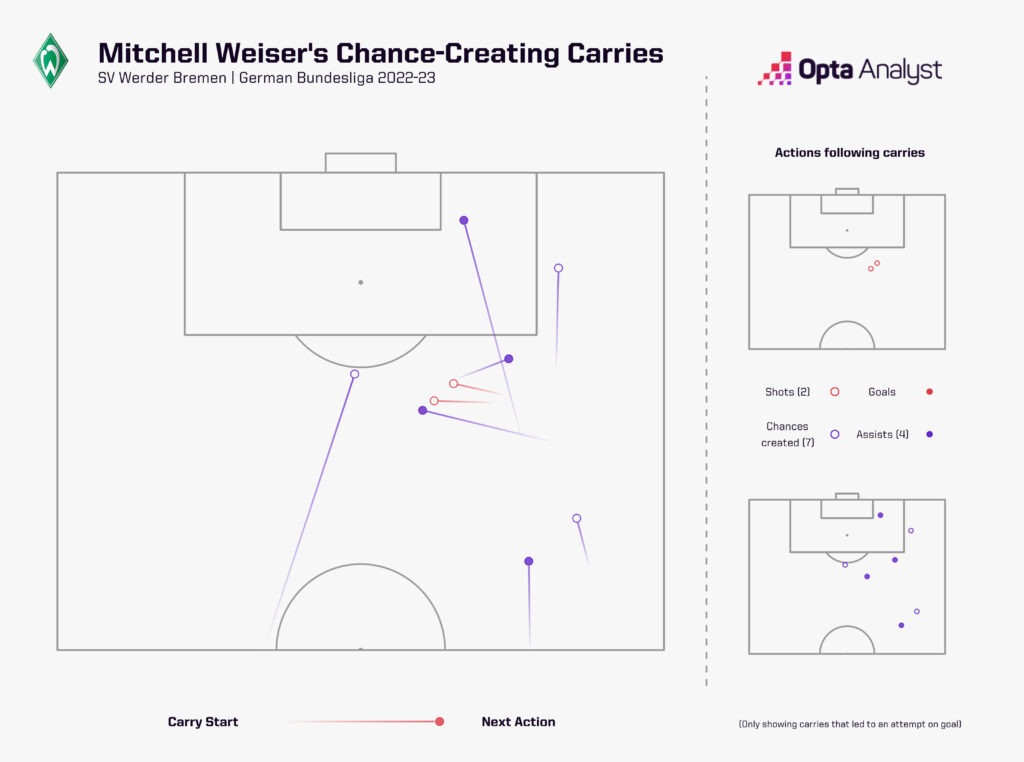
Closer to the penalty area, Füllkrug is also surprisingly good at turning defenders after receiving to feet and arriving in to positions to attempt shots and test the keeper.
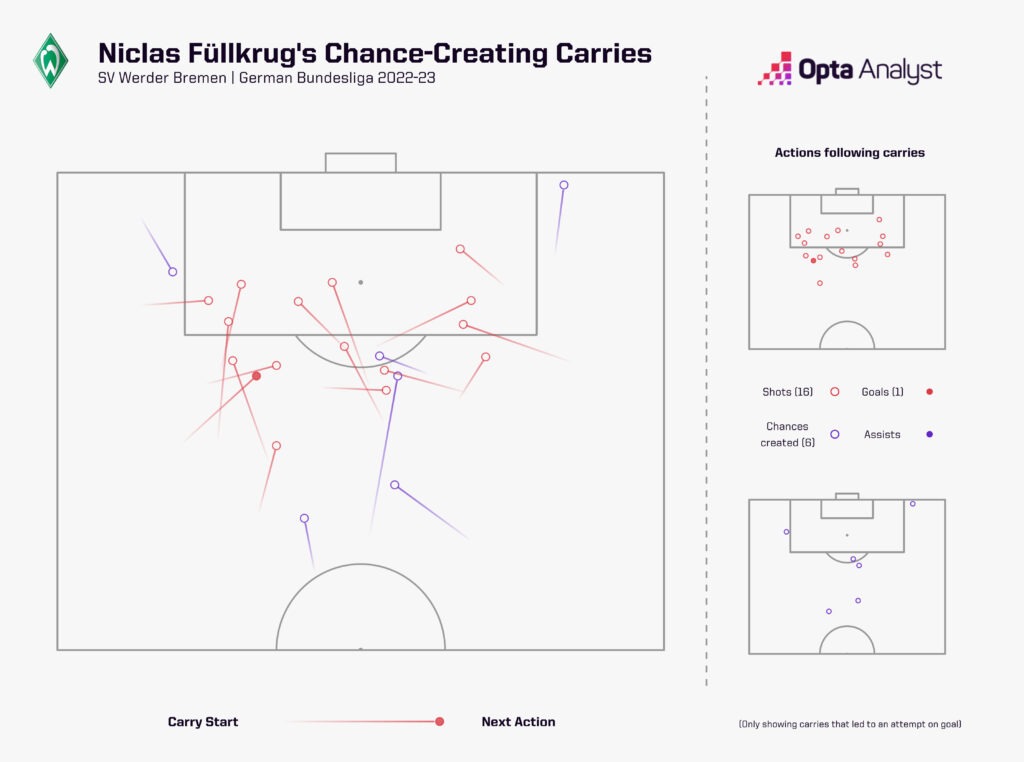
Generating these shots via his carries is another interesting side to his game and in the first half of the Bundesliga season, only Thuram (19) and Dodi Lukebakio (17) had more carries leading to a shot than Füllkrug (16).
Given his current shot-production and steady underlying numbers, Füllkrug is comfortably on-course to beat his previous record tally of goals in a Bundesliga season. With 19 matchdays still left in the Bundesliga this campaign and the Werder Bremen striker only four off his 14-goal record from 2017-18, expect more to come from the German in 2023.
As a key player for Werder not just in front of goal, but in build-up play and creation of chances, it’s not a stretch to compare Füllkrug to Kane, both in terms of style and importance to his club.
There are similarities between the two in terms of the roles they perform for their side – and whilst most outsiders may yet see him as just a target man, his performances for Bremen so far this season have proven he is much, much more than that.
Enjoy this? Subscribe to our newsletter to receive exclusive content.
The post Niclas Füllkrug: Germany’s New ‘Old’ Striker Continues His Ascent appeared first on The Analyst.
[ad_2]
Read Entire Article

